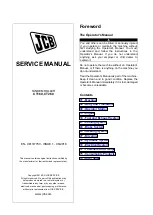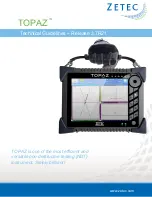
VF / DSL Cable Qualifier
10
Figure 3B - A Pulse Reflection indicates a load coil at 500 ft (152 m)
TDR’s can use various methods of testing to determine the location of problems along the length of the cable
under test. Impedance is a major player. The TDR equipment looks for a change in impedance which could
be caused by improper installation, cable damage (caused by water, etc.), end of cable, and a bridged tap.
The magnitude of the impedance changes determines the amplitude of the reflection.
There is a direct relationship between voltage pulse width sent down the cable and the distance that it travels
along the cable. The smaller the pulse, the less the energy it contains, and therefore, the distance that it
travels along the cable is less. Voltage pulses of greater width travel further distances. When using this
technique, it is best to start testing with voltage pulse of small width and to work up to pulses of larger width.
Voltage pulse width is typically measured in nanoseconds.
Several factors affect the operation of TDR devices and the results they display. As mentioned earlier in this
section, VOP, or Velocity of Propagation is a very important value to know in determining the distance to an
impairment. VOP represents the speed at which energy travels through a medium. In the case of xDSL, the
medium is a copper twisted pair. VOP is measured as a percentage of the speed of light in a vacuum. Users
of TDR’s may see the VOP expressed as 0.66 or 66%; both are acceptable.
VOP is an extremely important parameter. It must be correct, as any deviations may give the user false
readings. Most cable manufactures will indicate the VOP for their particular cable. The VOP depends upon
cable diameter, material out of which the cable is made, and on impurities in this material.
1000 ft (300 m)
VOP = 62%
VOP = 64%
VOP = 66%
X
X
Figure 3C – Selecting the correct VOP means knowing the correct distance
When using the TDR technique, the cable under test should not be terminated. Cables that are terminated
absorb most or all of the energy pulse sent down the cable which, in turn, means that no energy is reflected
back to the TDR device. When using the CableSHARK’s TDR function, ensure that the far end of the cable
is configured as an OPEN or SHORT circuit.
Summary of Contents for CableSHARK P3
Page 1: ......
Page 10: ...VF DSL Cable Qualifier viii...
Page 12: ...VF DSL Cable Qualifier x...
Page 26: ...VF DSL Cable Qualifier 14...
Page 36: ...VF DSL Cable Qualifier 24...
Page 64: ...VF DSL Cable Qualifier 52...
Page 80: ...VF DSL Cable Qualifier 68...
Page 184: ...VF DSL Cable Qualifier 172...
Page 192: ...VF DSL Cable Qualifier 180...
Page 224: ...VF DSL Cable Qualifier 212...
Page 228: ...VF DSL Cable Qualifier 216...
Page 262: ...VF DSL Cable Qualifier 250 CSA Loop 6 CSA Loop 7 CSA Loop 8 Extended CSA Loop 9...
Page 263: ...CableSHARK P3 User Guide 251 Extended CSA Loop 10 Mid CSA Loop 0 Mid CSA Loop 1 Mid CSA Loop 2...
Page 264: ...VF DSL Cable Qualifier 252 Mid CSA Loop 3 Mid CSA Loop 4 Mid CSA Loop 5 Mid CSA Loop 6...
Page 265: ...CableSHARK P3 User Guide 253 ANSI Loop 2 ANSI Loop 3 ANSI Loop 4 ANSI Loop 5...
Page 266: ...VF DSL Cable Qualifier 254 ANSI Loop 6 ANSI Loop 7 ANSI Loop 8 ANSI Loop 9...
Page 267: ...CableSHARK P3 User Guide 255 ANSI Loop 11 ANSI Loop 12 ANSI Loop 13 ANSI Loop 15...
Page 268: ...VF DSL Cable Qualifier 256...
Page 286: ...VF DSL Cable Qualifier 274...
Page 292: ...VF DSL Cable Qualifier 280...
Page 294: ...VF DSL Cable Qualifier 282...
Page 316: ...VF DSL Cable Qualifier 304...
Page 318: ...VF DSL Cable Qualifier 306...
Page 319: ...CableSHARK P3 User Guide 307 Notes...
Page 320: ...VF DSL Cable Qualifier 308...















































